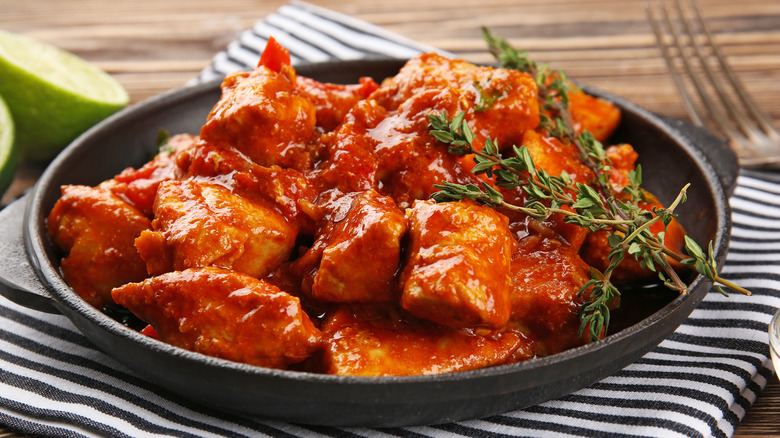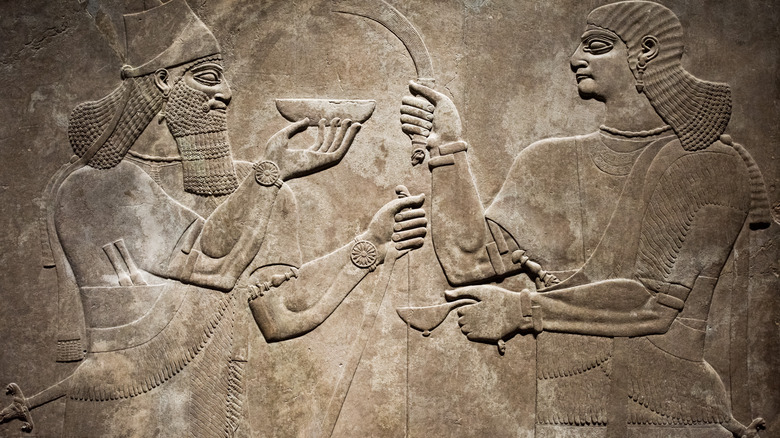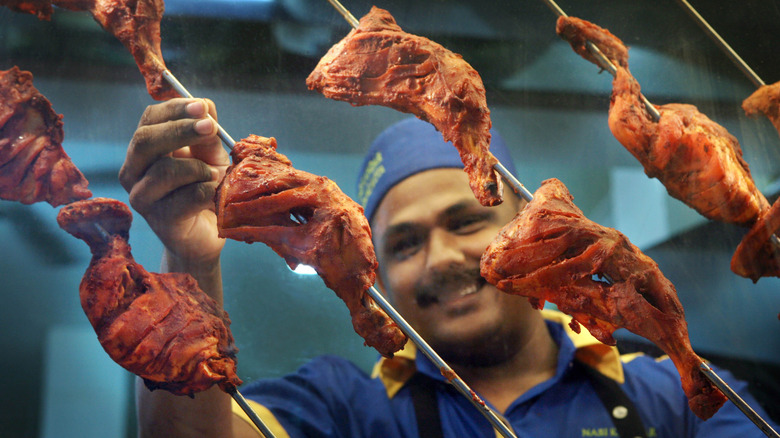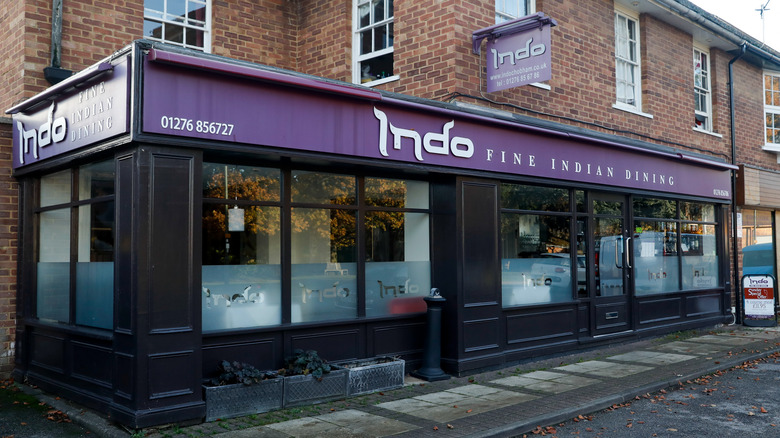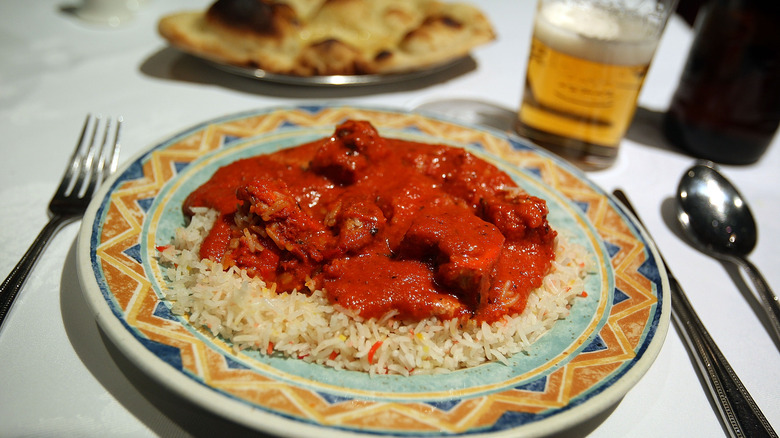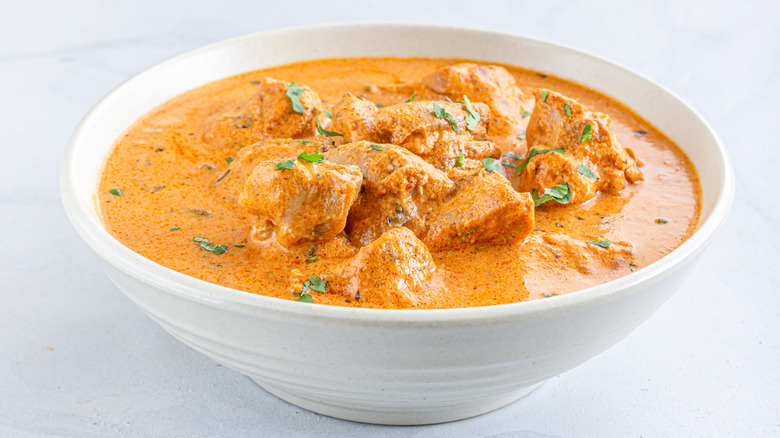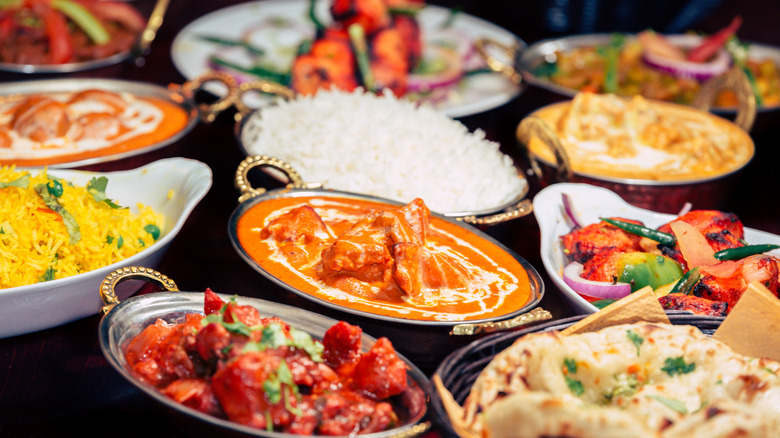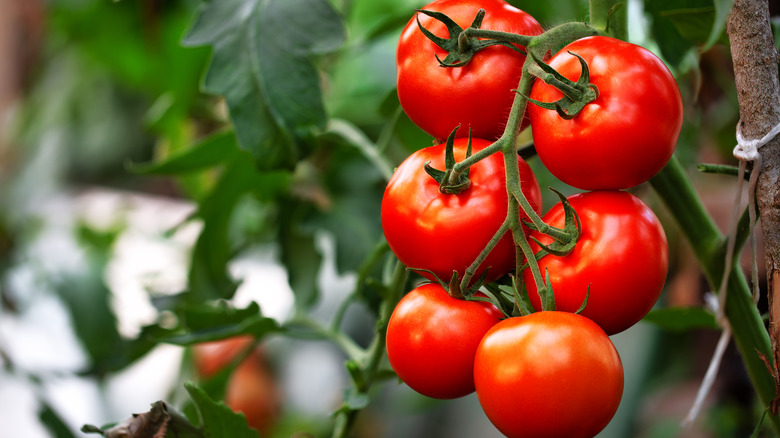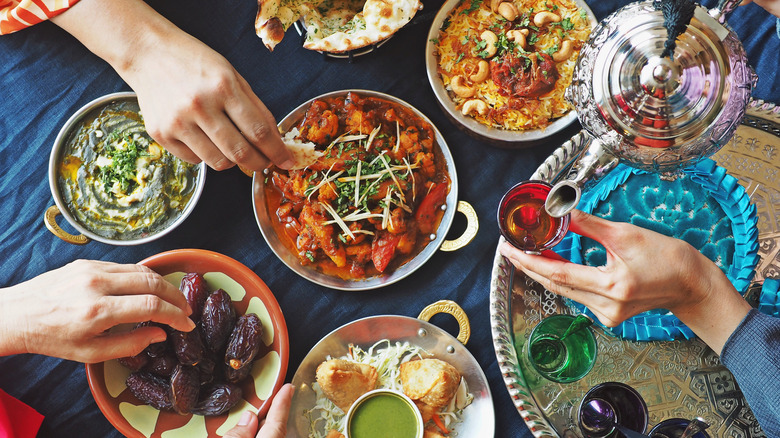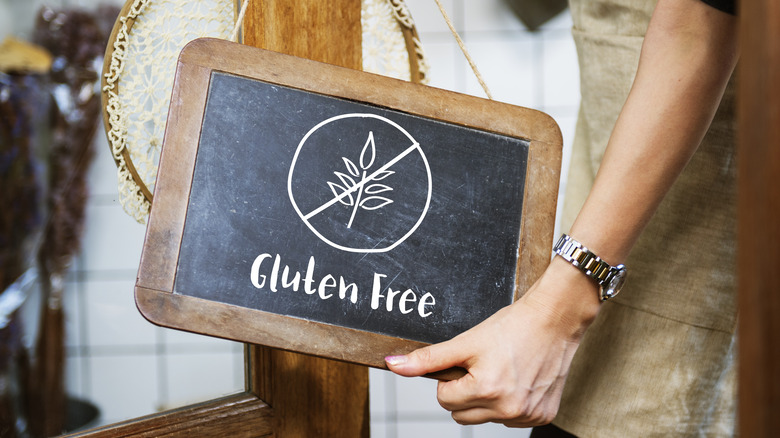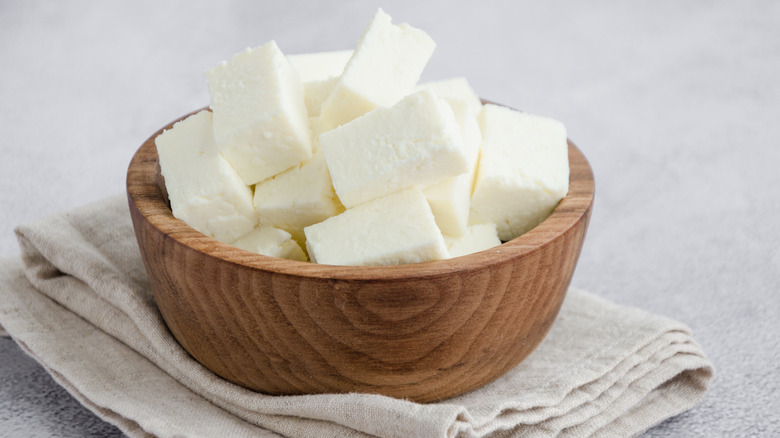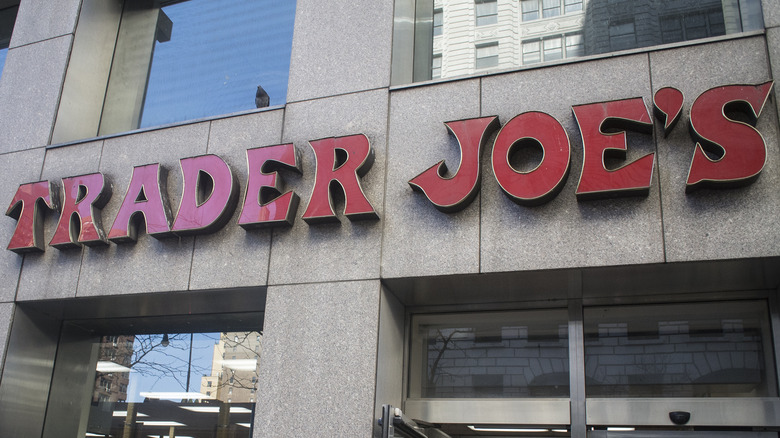The Untold Truth Of Chicken Tikka Masala
Since the dawn of the 21st century, Indian cuisine has been steadily growing in popularity in the United States. (It has long been beloved in the United Kingdom.) In fact, Indian food is among the top four most popular cuisines across the entire globe (alongside Italian, Japanese, and Chinese) according to "Dining Out as Cultural Trade" by Joel Waldfogel for the National Bureau of Economic Research.
One of the most popular Indian dishes that you will find on any Indian menu in the U.S. is chicken tikka masala, a type of curry that has captured the hearts and taste buds of people all across the Western world. It has also garnered more than its fair share of controversy. Just what is chicken tikka masala? Where does it come from? And why has it caused so much contention?
Let's dive in and discover everything there is to know about this deeply debated dish.
Its roots go back thousands of years
In its simplest form, chicken tikka masala is comprised of chunks of roasted chicken in a creamy, usually tomato-based curry sauce. A key ingredient is garam masala, a traditional Indian blend of spices used often in authentic cuisine. While the precise spices used to make garam masala vary by region, some common ones are coriander, cumin, cardamom, cloves, pepper, and cinnamon. Some believe that garam masala was first used in northern India 800 years ago, when it was part of the Mongol Empire.
As for the chicken, chunks of meat and vegetables marinated in spices and then cooked, the meaning of the word "tikka," were introduced to northern India by the Mughal dynasty, which ruled the region from the 1500s to 1700s.
However, a recipe for spiced meat with a sauce has been found written in cuneiform on a clay tablet that dates all the way back to 1700 B.C. near the ruins of Babylon in Iraq.
Chicken tikka and chicken tikka masala are not the same dish
As you may have gleaned from the previous paragraphs, chicken tikka and chicken tikka masala are not the same thing. Although chicken tikka is an integral part of creating chicken tikka masala.
Chicken tikka is prepared by first marinating small pieces of chicken in a mixture of yogurt and spices. Then the chicken is skewered and grilled in a special oven called a tandoor. Tandoors are traditionally cylindrical and made of clay. In addition to tikka, they are often used to bake bread.
Chicken tikka becomes chicken tikka masala with the addition of the curry sauce. Technically, a masala is a spice blend that has been ground into either a powder or a paste. (Garam masala, mentioned above, is one example of a masala.) However, dishes that make heavy use of these mixtures or pastes are often also referred to as masalas. Such is the case with chicken tikka masala.
It's not actually from India
Here is where controversy rears its ugly head. Given its deep roots and use of Indian cooking techniques as well as spices, one would think that chicken tikka masala is as Indian as the garam masala used to make it. Not so!
Many repeat the popular legend that chicken tikka masala was actually created in Scotland in the mid-20th century. Ali Ahmed Aslam of the restaurant Shish Mahal claims that a British man entered his restaurant in Glasgow and ordered chicken tikka. But the customer complained that the chicken was too dry. In order to please him, the chef added some spices to tomato soup, which he then poured over the chicken. The customer enjoyed it so much that he returned with his friends and ordered the same thing. Chicken tikka masala was then added to the restaurant's menu.
But that may not be the end of the story. Others have pointed to a recipe called shahi chicken masala that was published in the book "Indian Cookery" in 1961.
It was made to appeal to Western tastes
If the Scottish origin is indeed true, then it is fairly cut and dry that chicken tikka masala was made for a Western palate. Specifically, it was made for one man's personal tastes that were likely influenced by his British culture. In the U.K., meat is often served with gravy, such as in the very British Sunday roast.
Others argue that chicken tikka masala actually originated during the British Raj, a period from 1858 to 1947 when the British Empire ruled over the Indian subcontinent. Regardless of the exact creative moment, the British taste for Indian flavors did come with colonial rule.
During the Raj, countless South Asians migrated to the U.K., bringing flavors of home with them. Many opened shops and restaurants at first catering to their own communities. Over time, local Brits caught on, and, as is common with immigrant cuisines, some recipes were altered to suit the tastes of their new customers.
Chicken tikka masala is more popular than fish and chips in Great Britain
While people abroad may view fish and chips (fried fish fillets and french fries) as iconically British, many Britons themselves see things differently. Former British Foreign Secretary Robin Cook famously declared chicken tikka masala to be "a true British national dish" in a speech he gave in London on April 19, 2001. He used the dish as a prime example of Britain's multiculturalism and ability to adjust to what he called "external influences."
Elizabeth Buettner of the University of York said in her 2008 article in the Journal of Modern History that going out to enjoy Indian curry in the U.K. became popular in the 1960s. Immigration from the former British colonies had increased, and a shift was taking place within Britain from an emphasis on assimilation to integration. Eventually, this led to people like Robin Cook celebrating their country's multiculturalism rather than decrying it.
Today, chicken tikka masala is the most popular dish in the U.K. Fish and chips come in second.
Chicken tikka masala is similar to butter chicken
Chicken tikka masala is such a close relation to butter chicken, another popular Indian dish, that many speculate this is where it actually came from. The dishes have so many ingredients in common — chicken, yogurt, tomato paste, garam masala — that it can be difficult to tell the two apart. The main difference is in texture. Butter chicken is richer and creamier than chicken tikka masala, and it has a less pronounced tomato flavor.
Butter chicken was created by Kundan Lal Gujral either in Peshawar (now located in Pakistan) in the 1940s or Delhi, India, where Gujral relocated after the partition of India, in the 1950s. So not long before the emergence of chicken tikka masala over in Scotland. Gujral realized that his chicken tikka dried out over time, rendering it unsellable. Rather than waste the meat, he developed a tomato-based curry sauce to soak the chicken tikka in. The resulting texture was tender rather than tough, and the chicken was edible again.
It's a versatile dish with plenty of options
There is no doubt that people love chicken tikka masala, but many ask the question, "What do I serve with chicken tikka masala?" You can certainly enjoy it on its own, however, it turns out that chicken tikka masala is quite versatile and goes with many other delicious Indian foods.
Many frozen chicken tikka masala entrees pair it with rice to soak up the sauce. Some people prefer a flatbread, like naan, roti, or chapati, to sop up the leftover sauce. Potatoes also offer something with a slight, mostly neutral flavor. But for something a little more savory, try vegetable samosas, fritters, or even rice pilaf, which offers significantly more interest than plain basmati.
For a cooling balance to the spices in the masala, there is raita, a creamy dish made with yogurt and different vegetables such as cucumber or carrot. A thinner raita also makes a terrific dressing for a green side salad. Any fresh vegetable should cut the heat you may find in Indian cuisine.
And you can always wash it down with a masala chai, coconut water, lassi, or any of a number of traditional Indian beverages.
Chicken tikka masala is traditionally mild
While any food can be prepared to taste, there is no denying that Indian cuisine has a reputation for bringing the heat. But India is a large country with countless different food traditions, some spicier than others. Also, what is considered Indian in the West may in fact be Pakistani or Bangladeshi, so painting all cuisines from this region with one brush can be misleading.
Chicken tikka masala is meant to be mild. Think spiced not spicy. The aroma of the spices and flavor of the grilled chicken is what is on display here. And like with its equally mild cousin butter chicken, the sauce is built on a base of tomatoes and cream, both of which can temper the heat level of a dish. (Dairy is often used to dispel the heat of chili peppers.) Of course, if you want your dish spicy, you can always order it that way at a restaurant or make it so yourself at home. There is no customary level of heat, and there are countless variations of chicken tikka masala, each chef creating it to suit their own tastes.
If you want to try Indian food, but you don't want to set your tongue on fire, you should be safe with chicken tikka masala and its buddy butter chicken.
Chicken tikka masala has a lot of calories
When cream features prominently in a recipe, you know it can't be low-cal. Some recipes also call for ghee (clarified butter), one tablespoon of which can hold about 135 calories.
White rice, a common accompaniment to chicken tikka masala, has 200 calories. Brown rice has slightly more. You might be better off pairing with flatbread, but a single piece of naan still contains an average of 137 calories. Livestrong reports that, all together, one serving of chicken tikka masala can amount to 684 calories and 53 grams of fat. There could also be as much sodium as 1,414 milligrams.
The chicken provides protein, and healthier options are available when making the dish yourself. Substituting butter for ghee is one place to start. Extra virgin olive oil or coconut oil are also lower in fat. Adding more tomatoes raises the amount of fiber. Forgoing rice or bread on the side knocks out a few hundred calories right there. Maybe give that raita-topped green salad mentioned above a try.
Chicken tikka masala is naturally gluten free
Celiac disease and gluten intolerance are being increasingly diagnosed by physicians in the United States. While switching to a gluten-free diet can be frustrating, there are numerous foods and cuisines that are naturally gluten-free. Happily, Indian fare is one of them.
The primary grain of India is rice. In fact, India is the second highest rice-producing country in the world. Another gluten-free grain that India grows in abundance is sorghum. A common crunchy snack in India is popped sorghum (also called jowar dhani), which is similar to popcorn but is a more healthful alternative.
The most popular thickening agent in cooking is wheat flour, which India also produces, but it isn't required when making the sauce for chicken tikka masala. When served with white or brown rice, vegetables, greens, or fruit rather than bread, chicken tikka masala maintains its inherently gluten-free status.
There are just as tasty vegetarian and vegan alternatives
You might be surprised to learn that vegetarians and vegans need not be left out of the chicken tikka masala craze. A popular vegetarian alternative to chicken tikka masala is paneer tikka masala. Chunks of paneer are substituted for the chicken. Paneer is a soft cheese, similar to cottage cheese, that is traditionally made from buffalo milk, or a mixture of buffalo and cow's milks. (A lower fat version uses entirely cow's milk.) Paneer can be made at home or purchased in a store.
A simple vegan alternative to both chicken tikka masala and paneer tikka masala is to make the dish with cubes of extra firm tofu instead of either chicken or cheese. Dairy-free yogurt stands in for conventional yogurt or cream, and vegetable oil is used in place of ghee or butter.
Tofu is highly absorbent, soaking up the flavors of whatever you put it in, which is why so many people like using it in cooking and why it makes such an awesome meat substitute in chicken tikka masala. This dish is all about flavor, and through tofu, vegans get to experience this too.
Trader Joe's customers give it rave reviews
Chicken tikka masala is a winner! At Trader Joe's that is. In its 13th Annual Customer Choice Awards, released in January 2022, the Trader Joe's chicken tikka masala frozen meal scored runner up in the Favorite Entree category. (Mandarin orange chicken came in first.)
Reviewer Bobby at Trader Joe's Reviews said of the chicken tikka masala, "Very close in flavor/texture to the chicken tikka masala you might encounter at a North Indian restaurant." Others agreed on the authenticity and quality of the dish, giving it an average rating of nearly five out of five stars.
Vegetarians are not left out of this market either. With slightly fewer reviews, Trader Joe's Paneer Tikka Masala has a full five out of five stars. Reviewer Lana C. called it "some of the best Indian food I've ever had from any store," even putting it on par with some authentic Indian restaurants.
